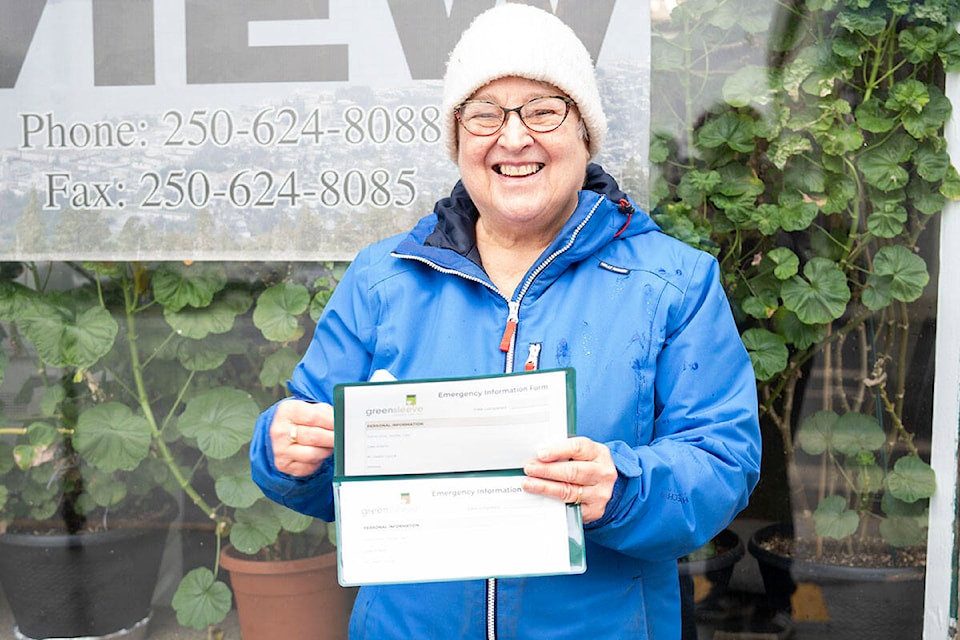The Greensleeve Program is coming to the Ashcroft, Cache Creek, Clinton, and Spences Bridge area, providing residents with the opportunity to have health care information quickly and easily available for ambulance paramedics in case of an emergency.
The program, or something similar, is already in use in the Fraser and Northern Health areas, Alberta, and elsewhere. In this region, the Greensleeve Program is being spearheaded by the Ashcroft and Area Community Resource Society in conjunction with the Ashcroft HUB, and was developed with input from local ambulance paramedics.
The simple, free program consists of plastic “green sleeves” which contain a form on which people record medical information, such as their Health Card number, the name and phone number of their family doctor, any allergies or medical conditions, and any medications they are currently taking. The sleeve can then be affixed to the fridge with magnets, or put in a visible, easily accessible drawer or cupboard.
Stickers are provided for exterior doors, which will alert ambulance paramedics to look for the green sleeve. Another sticker can be used to indicate the drawer or cupboard where it is located.
The Community Resource Society’s Esther Lang says that the organization has been working on developing the form and implementing the program in this region for a year or so.
“We recognized from some of the things happening in town that there was need for it. We discussed it with local paramedics and they were most encouraging and gave us information.”
Lang adds that the society had looked into the similar “blue bottle” program that London Drugs used to have, but it was so long ago that no one at London Drugsw had any information about it. “We decided to go with the Greensleeve Program instead, as it was easier to get those.”
Grant funding to purchase the sleeves and launch the program was obtained from the United Way. While the sleeves are provided, the form requesting information had to be developed by the Community Resource Society, which Lang says took a lot of deliberation.
“The primary obstacle was time and getting it right. We didn’t want to have to backtrack and re-do things. We had to be careful about what information is on the form because of privacy issues, so had to do a lot of background work about that.
“We looked at the forms from Northern and Fraser Health and one from the Island, and sat down with ambulance personnel to see what needed to be added or taken off, so that we got it right. We’ve been through a lot of hoops.”
She adds that while the forms contain a list of stock questions, people can give as much or as little information as they want. “It’s to their advantage to give as much information as possible, but it’s their business.”
In addition to the form provided with the sleeve, other relevant medical information can be included, such as a DNR (Do Not Resuscitate) or MOST (Medical Orders for Scope of Treatment) document signed by a doctor.
The idea behind the program is to provide ambulance paramedics with the most comprehensive medical information possible in the event that they are called to someone’s home and there is no one who can answer questions.
Even in cases where someone is not unconscious or incapacitated in some way, it can be a stressful time, and people might not remember to pass along vital information such as what medications a person is taking and where to find them, or who to contact in case of an emergency. The form even has a space to record who should be contacted to see to any pets in the residence, in the event that they need to be looked after.
Lang notes that the Greensleeve Program is a free service. The information that users provide is not stored anywhere; it is only for use in an emergency situation.
She says that the Community Resource Society is planning a series of public meetings throughout the area, with dates and locations to be announced. In addition to picking up a green sleeve at the meeting, people will be able to learn more about the program and ask questions of health care professionals. Information about where to obtain the green sleeves if you can’t attend a meeting will also be forthcoming.
“Everybody really needs it,” says Lang. “We started out thinking about seniors and disabled people and people who live by themselves, but the program is useful for anybody.”
editorial@accjournal.ca
Like us on Facebook and follow us on Twitter
